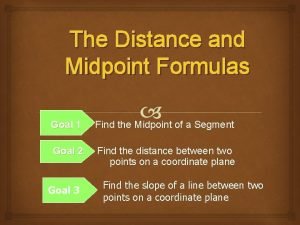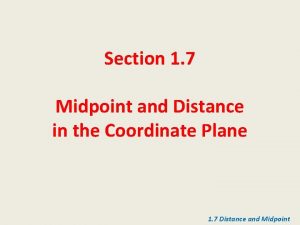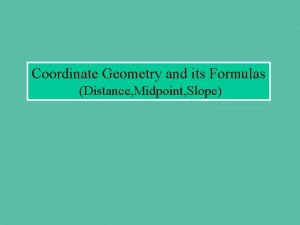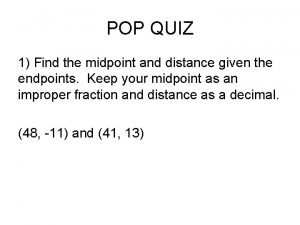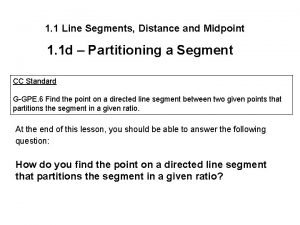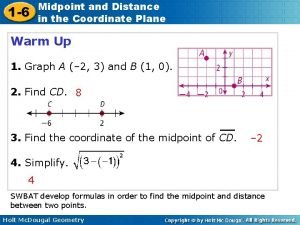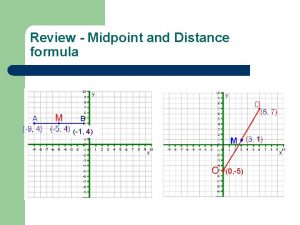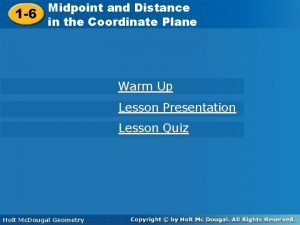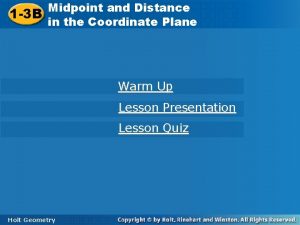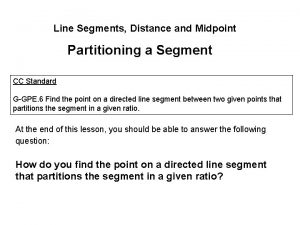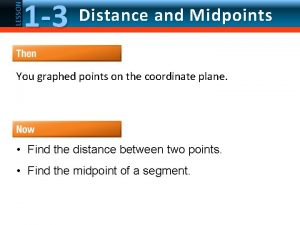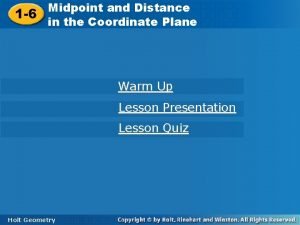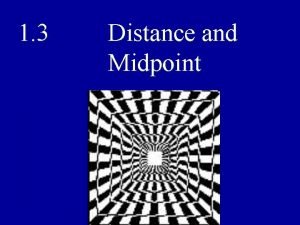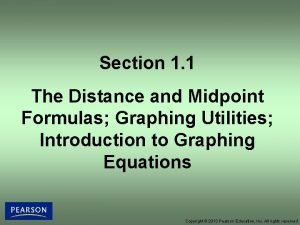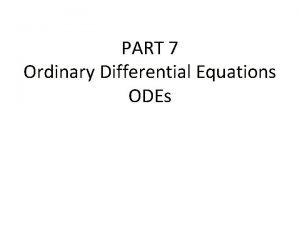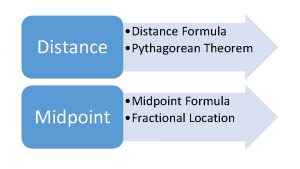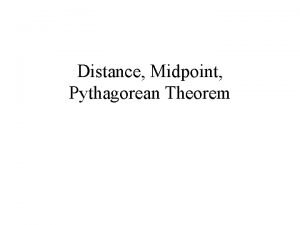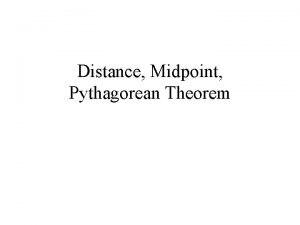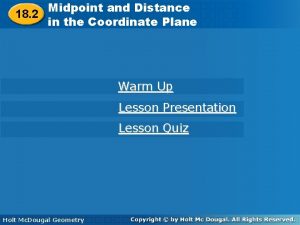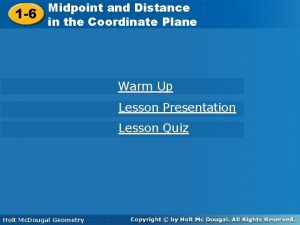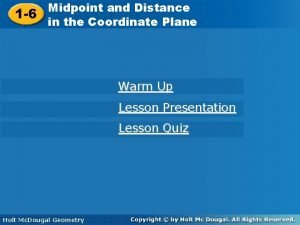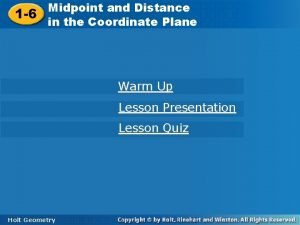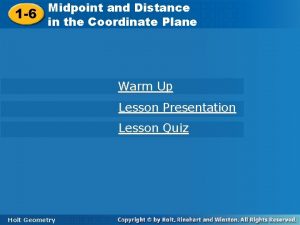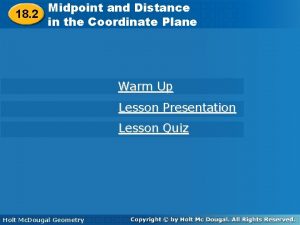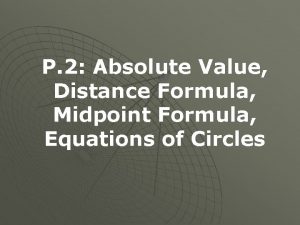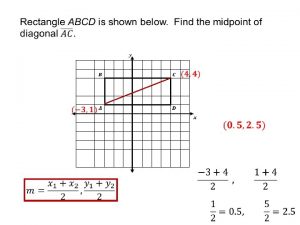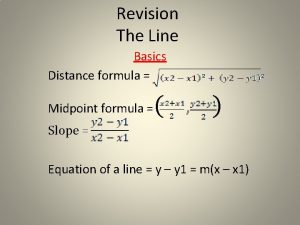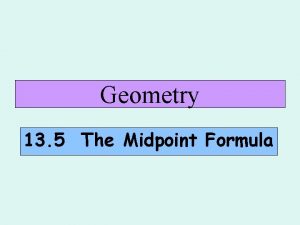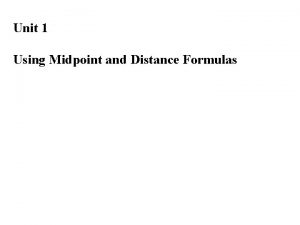Review Midpoint and Distance formula D A M






















- Slides: 22

Review - Midpoint and Distance formula D A M B B (-9, 4) (-5, 4) (-1, 4) (6, 7) M • (4. 5, 4) C (3, 1) C • (0, -5)

Questions on Homework 1. 3? ?

Warm up 1. The sum of two numbers is 90 and one number is 4 times the other. Write an equation and solve to find the numbers. ANSWER 2. Find m ANSWER x + 4 x = 90; 18, 72 ABD. What kind of angle is it? 180° , straight

Questions on 1. 4?

1. 5 Lesson Describe Angle Pair Relationships

Complementary Angles 2 angles that add to equal 90. Examples: Way to remember: “It is right to give complements”

Supplementary Angles 2 angles are supplementary if the sum of their angle measure is 180. Example: These two angles are supplementary. Note that these two angles can be "pasted" together to form a straight line! Way to remember: “S stand for straight”

Adjacent Angles 2 angles next to each other that share a common vertex and side, but have no common interior points. A & B are adjacent angles

GUIDED PRACTICE 1. for Example 1 In the figure, name a pair of complementary angles, a pair of supplementary angles, and a pair of adjacent angles. Because FGK and HGK share a common vertex and side, they are adjacent. Because 41° + 49° = 90°, FGK and GKL are complementary angles. Because 49° + 131° = 180°, supplementary angles. HGK and GKL are

GUIDED PRACTICE 2. for Example 1 Are KGH and LKG adjacent angles? Explain. Nope! While they do share a common. Adjacent angles do not have common interior points.

EXAMPLE 2 Find measures of a complement and a supplement a. Given that find m 2. 1 is a complement of 2 and m SOLUTION a. You can draw a diagram with complementary adjacent angles to illustrate the relationship. m 2 = 90° – m 1 = 90° – 68° = 22 1 = 68°,

EXAMPLE 2 b. Find measures of a complement and a supplement Given that find m 3. 3 is a supplement of 4 and m 4 = 56°, SOLUTION b. You can draw a diagram with supplementary adjacent angles to illustrate the relationship. m 3 = 180° – m 4 = 180° – 56° = 124°

EXAMPLE 3 Find angle measures Sports When viewed from the side, the frame of a ballreturn net forms a pair of supplementary angles with the ground. Find m BCE and m ECD.

EXAMPLE 3 Find angle measures SOLUTION STEP 1 m Use the fact that the sum of the measures of supplementary angles is 180°. BCE + m ∠ ECD = 180° Write equation. (4 x+ 8)° + (x + 2)° = 180° 5 x + 10 = 180 5 x = 170 x = 34 Substitute. Combine like terms. Subtract 10 from each side. Divide each side by 5.

EXAMPLE 3 Find angle measures STEP 2 Evaluate: the original expressions when x = 34. m m BCE = (4 x + 8)° = (4 34 + 8)° = 144° ECD = (x + 2)° = ( 34 + 2)° = 36° ANSWER The angle measures are 144° and 36°.

Angles Formed by the Intersection of 2 Lines Click Me!

Linear Pair A linear pair is formed by two angles that are adjacent (share a leg) and supplementary (add up to 180°) “forms a line”

Vertical Angles A pair of non-adjacent angles formed by the intersection of two straight lines “When you draw over the 2 angles it forms an X”

EXAMPLE 4 Identify angle pairs Identify all of the linear pairs and all of the vertical angles in the figure at the right. SOLUTION To find linear pairs, look for adjacent angles whose noncommon sides are opposite rays. ANSWER 1 and 4 are a linear pair. are also a linear pair. 4 and To find vertical angles, look or angles formed by intersecting lines. ANSWER 1 and 5 are vertical angles. 5

Example 5 Two angles form a linear pair. The measure of one angle is 5 times the measure of the other. Find the measure of each angle.

Example 6 Given that m 5 = 60 and m 3 = 62 , use your knowledge of linear pairs and vertical angles to find the missing angles.

Wrap Up n sketches the angle pairs I describe. n be sure to make up angles measures that would fit the description. n There are millions of answers that could be correct. n If it is not possible, write not possible.
 Distance and midpoint formulas
Distance and midpoint formulas Distance and midpoint formula
Distance and midpoint formula Midpoint word problems
Midpoint word problems Slope and midpoint formula
Slope and midpoint formula Distance midpoint formula
Distance midpoint formula Midpoint and distance in the coordinate plane worksheet
Midpoint and distance in the coordinate plane worksheet Quiz distance and midpoint
Quiz distance and midpoint Midpoint in the coordinate plane
Midpoint in the coordinate plane 9-1 midpoint and distance formulas
9-1 midpoint and distance formulas Partitioning a segment formula
Partitioning a segment formula Midpoint and distance in the coordinate plane
Midpoint and distance in the coordinate plane Distance midpoint and angle measurement
Distance midpoint and angle measurement Lesson 1-6 midpoint and distance in the coordinate plane
Lesson 1-6 midpoint and distance in the coordinate plane Practice b midpoint and distance in the coordinate plane
Practice b midpoint and distance in the coordinate plane Partitioning a line segment formula
Partitioning a line segment formula Lesson 1-3 midpoint and distance
Lesson 1-3 midpoint and distance Lesson 1-6 midpoint and distance in the coordinate plane
Lesson 1-6 midpoint and distance in the coordinate plane 1-3 midpoint and distance
1-3 midpoint and distance Distance & midpoint formulas
Distance & midpoint formulas Distance and displacement
Distance and displacement The ratio of input distance to output distance
The ratio of input distance to output distance Midpoint method formula
Midpoint method formula Find missing endpoint
Find missing endpoint
